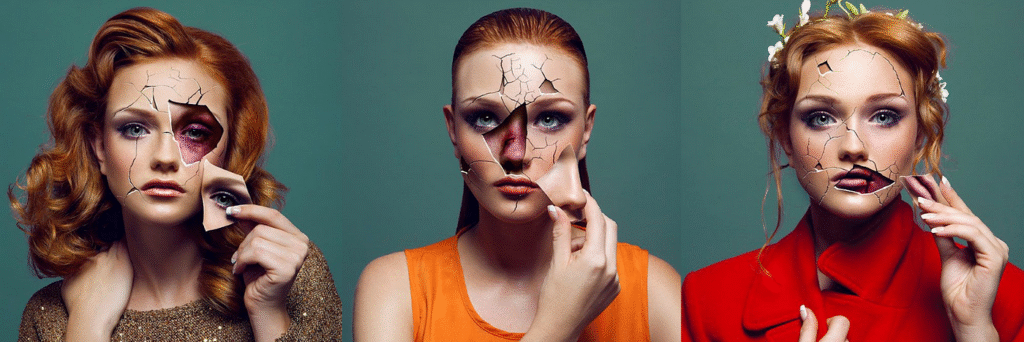In a world where selfies dominate screens and red carpets set trends, one thing is clear: our perception of beauty has shifted.
What was once a diverse and personal expression of identity has become a global race toward perfection—choreographed by movies, touched up by filters, and fueled by followers.
But in this quest to look flawless, have we lost sight of true beauty?

Let’s take a deep dive into how cinema and social media reshaped our ideas of beauty—and how we can reclaim our reflection.
What Is True Beauty, Really?
Before makeup tutorials, filters, or celebrity endorsement deals, beauty was a rich and cultural experience. It was never one-size-fits-all.
In different parts of the world, beauty was seen through diverse lenses:
- In Africa, curves symbolized abundance, and darker skin was prized.
- In Asia, natural grace, modesty, and inner calm were idealized.
- Indigenous cultures celebrated beauty through traditional marks, body art, and spiritual significance.
True beauty wasn’t something to be bought or downloaded—it was lived. It was about how you carried yourself, how you made others feel, and how you honored your roots.
Then came the screen—big and small—and everything changed.
Hollywood: The Scripted Ideal
Hollywood didn’t invent beauty standards, but it certainly streamlined them. For over a century, the global film industry pushed a very specific version of beauty.
Think about the iconic actresses who defined eras: Marilyn Monroe, Audrey Hepburn, Angelina Jolie, Scarlett Johansson. While undeniably beautiful, they represented just one facet of beauty—usually slim, white, symmetrical, and glamorously styled.
Characters who didn’t fit this mold? Often sidelined as comic relief, villains, or the “before” in a makeover montage.
Over time, viewers around the world internalized these images as aspirational. The result? Local beauty standards were influenced—or in some cases, erased—by Western ideals.
Even in non-Western cinema, such as Nollywood or Bollywood, the Eurocentric beauty template began to dominate. Lighter skin, straight hair, and slim waists became more common on-screen, despite the diversity in the audience watching.
The Digital Era: Social Media’s Mirror
If movies planted the seed, social media watered and fertilized it into a forest of unattainable ideals.
Platforms like Instagram, Snapchat, and TikTok have turned everyone into both a viewer and a performer. With face-tuning apps and AI filters, the pressure to look perfect isn’t just for celebrities anymore—it’s expected from the average user.
Every scroll shows:
- Sculpted faces without pores.
- Hourglass bodies without waist trainers.
- Glowing skin without blemishes or effort.
What’s worse? These aren’t real depictions. They’re edited, filtered, and framed. And yet, they’re presented as normal, casual, and effortless.
This blurs the line between authenticity and fantasy, leading many—especially younger users—to question their worth based on likes and comparisons.
The Psychological Toll: Beauty and Mental Health
In this environment, it’s no surprise that self-esteem is suffering. And it’s not just anecdotal—there’s hard evidence to back it up.
- A Harvard study found that teenage girls who spend more time on social media report higher levels of body dissatisfaction.
- Eating disorders are rising among both young men and women, partly linked to body-image content on apps.
- The “Snapchat dysmorphia” phenomenon describes people undergoing plastic surgery to look like their filtered selfies.
This isn’t about vanity—it’s about validation. People, especially teens, are equating their value with appearance, and appearance with perfection. When your worth is tied to your looks—and your looks never seem good enough—it’s a recipe for chronic dissatisfaction.
The Cultural Fallout: Eroding Diversity
Beyond individual self-esteem, there’s a broader cultural cost.
Traditional beauty practices, once passed down through generations, are being replaced with a globalized, homogenized standard. This standard is often:
- Lighter-skinned
- Eurocentric in features
- Thin, tall, and youthful
- Glossy and hyper-feminine
In Nigeria, for example, there’s been a surge in skin-lightening products, straight hair wigs, and cosmetic surgery procedures. Similarly, in Korea, India, and Brazil, people are altering their noses, jaws, eyelids, or skin tones to meet global beauty expectations.
These aren’t just personal choices—they reflect deep-seated cultural shifts. We’re watching ancestral pride get replaced by digital validation.
Beauty as a Commodity
Another twist in the story is how beauty has become commercialized. With the rise of influencers, appearance isn’t just admired—it’s monetized.
From beauty brands to skincare routines to fashion hauls, looking good is a full-time job. Influencers market lifestyles as much as products, and the message is often clear: “If you look like me, you’ll be successful, admired, and loved.”
This cycle encourages people to:
- Buy more.
- Compare more.
- Edit more.
- Show less of their real selves.
And behind it all is a booming economy making billions off our insecurities.
The Rise of the Real: The New Beauty Revolution
But all hope isn’t lost.
There’s a powerful counterculture growing—one that embraces realness over perfection. And it’s being led by people tired of chasing an illusion.
1. The Body Positivity Movement
What started on Tumblr and Instagram is now global. Activists and everyday users are celebrating:
- Stretch marks
- Acne
- Natural hair
- Disabled bodies
- All skin tones and sizes
The message is clear: beauty isn’t limited—it’s limitless.
2. Inclusive Representation
Brands and platforms are slowly catching on. Dove’s “Real Beauty” campaign, Fenty Beauty’s wide shade range, and Aerie’s unretouched models are setting new industry standards.
Even film and television are shifting. From “Black Panther” to “Bridgerton,” we’re seeing more diverse casting, more natural beauty, and more authentic storytelling.
3. Celebrity Advocacy
Stars like Lizzo, Zendaya, Jameela Jamil, and Lupita Nyong’o are using their voices to challenge norms and embrace authenticity.
They’re showing that fame and flaws can co-exist—and that being real is powerful.
Reclaiming Beauty: What Can You Do?
You don’t have to delete your accounts or boycott every movie. Reclaiming beauty starts with small, intentional choices. Here’s how to shift the narrative in your own life:
1. Audit Your Feed
Unfollow pages that trigger self-doubt. Follow people who inspire confidence, realism, and joy.
2. Go Filter-Free Occasionally
Let your skin breathe, and let your followers see it. You’d be surprised how many people will appreciate your transparency.
3. Compliment Differently
Tell people they’re brilliant, thoughtful, creative, or strong. Shift from appearance-based validation to value-based praise.
4. Celebrate Your Culture
Wear your traditional hair, clothes, and features with pride. Beauty is rooted in heritage—don’t trade it for a trending template.
5. Start Conversations
Talk about beauty pressures with friends, family, and even on social media. Challenge the myths and build a new community standard.
The Future of Beauty Is… You
The truth is, we’ll probably never escape the influence of media entirely. But we can rewrite the story.
Instead of chasing perfection, we can embrace presence. Instead of comparing, we can connect. Instead of conforming, we can express.
Beauty is not a mold to fit—it’s a light to reflect. And that light shines brightest when you are most yourself.
So, the next time you catch your reflection or scroll past another picture-perfect post, ask yourself:
Am I seeing beauty—or just someone else’s version of it?
Because the most powerful thing you can be in a world full of filters is real.

